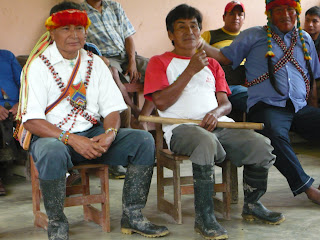We are gearing up for The Field Museum's 24th rapid inventory. Our rapid inventories are quick surveys of the biological diversity and social strengths of an area, with the aim of ensuring the place gets protected and managed in the long-term. Follow along as we explore one of the more remote parts of Peru.
 |
| Crossing the Kampankis in a single-engine propeller plane |
The Kampankis mountains reach up to 1,000 m, and remain entirely unexplored by scientists. Given their isolation from the Andes, they will almost certainly be chock-full of new species.
The local indigenous residents (Huampis, Awajun, Shuar) live along the rivers on either side of the mountain range and have a deep connection to these lands, and a long history of protecting it from outsiders. We have worked with them for the last two and a half years, with many twists and turns along the way, building towards our joint rapid inventory.
 |
| Workshop in Shoroya on the Morona River |
Starting August 1st we will spend three weeks in the field, with a team of biologists surveying the soils, rocks, plants, fishes, frogs, snakes, birds, and mammals in the mountains, and a team of social scientists documenting the cultural and organizational strengths of the local people. At the end the two teams will come together, along with local residents and decision-makers, to draft recommendations that would protect these lands in the way that makes the most sense for local people and for the region's fauna and flora. Right now we are in a preparation frenzy, pulling together all of our gear, and finishing last-minute logistics.
 |
| Kampankis mountains as seen from village of Chapiza, Santiago River |
By the night of July 31st, our whole team should be in Peru... and then the inventory begins!
We are imagining that we will have updates from the team in the field every three days or so. Stay tuned.
Post by Corine Vriesendorp, Conservation Scientist


No comments:
Post a Comment